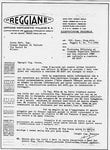Twitch
Staff Sergeant
I put up a pic of this plane before http://www.ww2aircraft.net/forum/aviation/italian-bombers-3022-4.html?highlight=Re-2007 and cheddar cheese said it was never a design concept. How come not saying so now?
Here's the background I gave on it. BTW it was to use a PAIR of 004Bs
REGGIANE
Early Italian jet experimentation with indigenous power plants, such as the Caproni-Campini N.1 that used a 900 HP Isotta-Fraschini piston engine and ducts to produce jet thrust, were lackluster but Italy almost had a potent jet. The 1943 Reggaine Re-2007 was to use the Junker Jumo 004B with 1,980 lbs. thrust.
The open exchange of ideas and material between Germany and Italy saw interesting applications in the aviation field such as using Daimler-Benz piston engines on Italian prototypes. When the Jumo was seen as a possible source of power Reggaine laid out a small fighter design. For the time, right before Italy's capitulation, the craft looked quite a lot like contemporary Reggaine piston engine fighters, which makes sense. Even the classic Reggaine tail was present on the horizontally oval-shaped 29.5-foot fuselage. Though the tail was non-swept the wings spanning 31.1 feet did have a slight sweep.
A certain Hauptmann (Captain) Bohm, was the Luftwaffe's senior engineer at the Reggiane plant, but even he was unable to obtain a positive decision concerning the supply of the two Junkers Jumo 004B's which had been promised by the Berlin. On January 7, 1944, Reggaine engineer Roberto Longhi wrote to Count Caproni, requesting that he intervene with the Germans as design work had diminished. Much of the rear fuselage, wing spars, ribs, undercarriage and the cockpit were already built but because of the inability to obtain adequately detailed dimensional specifications about the engine work once again halted.
In October 1944 the finished components were transported to the Caproni plant at Taliedo, where they remained until the end of the war. They were ultimately shipped to the US. The two Jumo 004B engines were sent to Italy, but were allegedly sold for scrap in Milan immediately after the withdrawal of German forces in Italy.
Keeping with the Italian lust for compact planes of high maneuverability the Re-2007 was that weighing just 7,788 lbs. loaded compared to around 14,000 lbs. for the Me 262. Its pair of 004Bs was buried in the fuselage for a very post-war look. The pilot's bubble canopy sat adjacent to the leading edge of the wings.
Maximum speed was estimated to be about 630 MPH while a range of 931 miles was estimated. Four 20 mm MG 151 cannon were to be the armament.
This jet was quite standard in every way and specifications seem legitimate.
Here's the background I gave on it. BTW it was to use a PAIR of 004Bs
REGGIANE
Early Italian jet experimentation with indigenous power plants, such as the Caproni-Campini N.1 that used a 900 HP Isotta-Fraschini piston engine and ducts to produce jet thrust, were lackluster but Italy almost had a potent jet. The 1943 Reggaine Re-2007 was to use the Junker Jumo 004B with 1,980 lbs. thrust.
The open exchange of ideas and material between Germany and Italy saw interesting applications in the aviation field such as using Daimler-Benz piston engines on Italian prototypes. When the Jumo was seen as a possible source of power Reggaine laid out a small fighter design. For the time, right before Italy's capitulation, the craft looked quite a lot like contemporary Reggaine piston engine fighters, which makes sense. Even the classic Reggaine tail was present on the horizontally oval-shaped 29.5-foot fuselage. Though the tail was non-swept the wings spanning 31.1 feet did have a slight sweep.
A certain Hauptmann (Captain) Bohm, was the Luftwaffe's senior engineer at the Reggiane plant, but even he was unable to obtain a positive decision concerning the supply of the two Junkers Jumo 004B's which had been promised by the Berlin. On January 7, 1944, Reggaine engineer Roberto Longhi wrote to Count Caproni, requesting that he intervene with the Germans as design work had diminished. Much of the rear fuselage, wing spars, ribs, undercarriage and the cockpit were already built but because of the inability to obtain adequately detailed dimensional specifications about the engine work once again halted.
In October 1944 the finished components were transported to the Caproni plant at Taliedo, where they remained until the end of the war. They were ultimately shipped to the US. The two Jumo 004B engines were sent to Italy, but were allegedly sold for scrap in Milan immediately after the withdrawal of German forces in Italy.
Keeping with the Italian lust for compact planes of high maneuverability the Re-2007 was that weighing just 7,788 lbs. loaded compared to around 14,000 lbs. for the Me 262. Its pair of 004Bs was buried in the fuselage for a very post-war look. The pilot's bubble canopy sat adjacent to the leading edge of the wings.
Maximum speed was estimated to be about 630 MPH while a range of 931 miles was estimated. Four 20 mm MG 151 cannon were to be the armament.
This jet was quite standard in every way and specifications seem legitimate.


